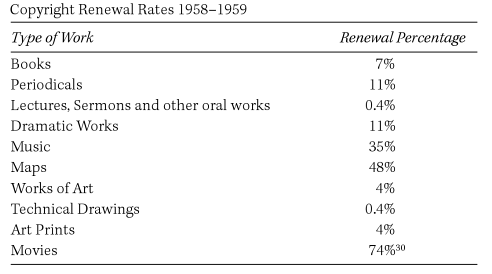At Techdirt, Mike Masnick makes the case for reducing the swollen length of time current copyrights are protected:
We’ve pointed a few times in the past to a chart from William Patry’s book, looking at how frequently copyright was renewed at the 28 year mark back when copyright (a) required registration and (b) required a “renewal” at 28 years to keep it another 28 years. The data is somewhat amazing:
As you can see, very few works are renewed after 28 years. Only movies, at 74% are over the 50% mark. Only 35% of music and only 7% of books tells quite a story. It makes it quite clear that even the copyright holders see almost no value in their copyrights after a short period of time. It appears that the Bureau of Economic Analysis is coming to the same conclusion from a different angle. As Matthew Yglesias notes, as part of its effort to recalibrate how it calculates GDP, the BEA is considering money spent on the creation of content an “investment” in a capital good, which needs to be depreciated over the time period in which it is valuable. Frankly, I’m not convinced this is the smartest way to account for money spent on the creation of content, but either way, the BEA’s analysis provides some insight into the standard “economic life” of various pieces of content, which match up with the chart above in many ways.




